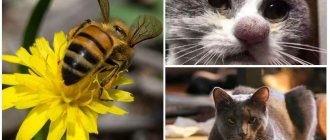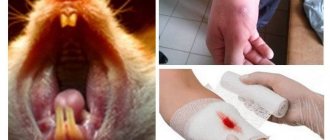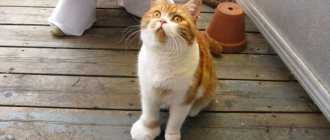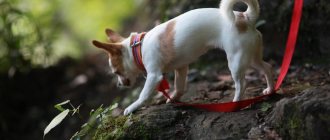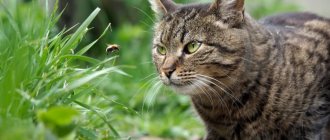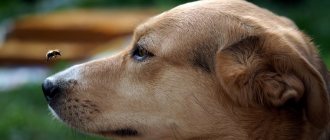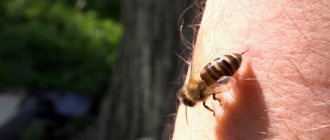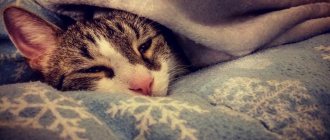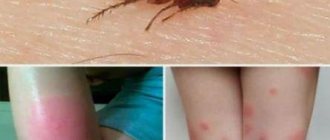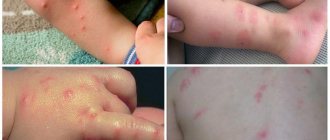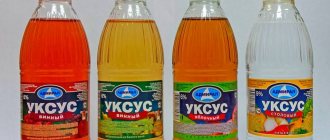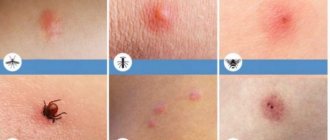Why are bee or wasp stings dangerous?
Among all hymenoptera insects, there are several species that most often sting people. This:
- bees;
- wasps;
- hornets;
- bumblebees.
Moreover, the first two have the dubious “honor” of being leaders in aggressive actions.
The danger of bites from these insects is somewhat exaggerated. Most people who are stung face no risk other than some discomfort. At the very moment of the sting, a sharp pain and burning sensation occurs at the site of the sting, which passes over time. Swelling immediately develops, and the more pronounced it is, the more fat or loose fiber there is under the wound. Redness after a bee or wasp sting is common.
The presence of fiber under the skin is an important factor influencing the general condition of a person after a sting. Danger arises from situations where the sting has stuck into the lip area, soft or hard palate, or tongue. In this case, a pronounced local reaction occurs in the form of severe swelling, which can block the upper respiratory tract, and the person will simply suffocate.
In general, the venom of wasps and bees is harmless. For it to kill a healthy person, it must be stung by several hundred insects. Even the stings of a dozen bees will only cause a general reaction in the form of a rise in temperature (more often in a child), chills, and weakness.
Allergic reactions to the venom of Hymenoptera (this group of insects includes wasps and bees) are much more dangerous. In this case, upon first contact with the poison, sensitization occurs, that is, a failure of the immune response. The second contact triggers a chain of pathological reactions, as a result of which an allergy develops.
Localized urticaria is considered the least dangerous - the appearance within a few minutes of skin itching, a spotted red rash on certain parts of the body (the spots merge, forming unevenly shaped reddened “fields”), and weakness, usually unexpressed, may occur. Swelling at the site of the bite is no different from swelling in the absence of allergies. When the rash spreads to the entire body, it is referred to as generalized urticaria - a more severe condition that is not yet life-threatening, but can become a harbinger of severe complications.
One of these severe conditions is Quincke's edema. In this case, the soft tissues of the face - lips, eyelids, cheeks - swell first. The transition of swelling to the neck is dangerous for the development of laryngeal edema - a deadly condition in which the upper respiratory tract is completely blocked. Death occurs within a few minutes from suffocation.
An even more dangerous, although rare, complication of a bee or wasp sting is anaphylactic shock. In this case, within a few minutes the patient’s blood pressure drops sharply, the pulse quickens, and the rash spreads throughout the body. The skin becomes pale and cold, sticky sweat appears. The outcome of anaphylactic shock is death from acute cardiovascular failure. But this is only if the patient is not helped.
What to process
There are many different ways to relieve the itching of a wasp sting. Depending on what tools are available to you, you can use them:
- Medicines;
- special remedies for bites;
- traditional methods.
Folk remedies
There are many simple ways to get rid of the itching after an insect bite. The natural acid found in various fruits can be used to neutralize toxic substances trapped under the skin. This will change the pH (acid-base balance) and reduce itching. Since in the summer there are a lot of fruits and plants at the dacha or dacha, the wound can be bandaged:
- apples, lemon, orange;
- tomatoes;
- plants.
Cut a healthy fruit and apply a piece to the wound. The fruit acid in the juice will get inside and neutralize the effects of toxins. This should be done immediately after the puncture, before the wounds heal.
You can also use plants you have in your garden and medicinal herbs. These include:
- Parsley,
- onion,
- Plantain,
- Aloe,
- dandelion.
These plants contain folic acid and other beneficial acids that act on the poison and change the pH of the skin. To get rid of itching, you can make herbal compresses or decoctions.
Parsley juice perfectly relieves itching and stops the inflammatory process. The plant must be crushed and applied to the sore spot. The same can be done with onions and plantain. This will relieve swelling and reduce swelling and itching.
A plant like aloe vera is known for its healing properties. You need to select a fleshy leaf, wash it well, and cut it to length. The mass is applied to the bite site for some time. Aloe has antibacterial, analgesic and anti-inflammatory properties.
Applying crushed dandelion leaves and roots to the wound helps a lot. From tansy and string, make a decoction that copes well with allergic reactions of the body. The composition can be used as a compress or drunk half a glass three times a day.
Effective remedies for wasp stings include baking soda and vinegar. They have a bactericidal and disinfectant effect, and also relieve swelling and itching. Dissolve half a teaspoon of baking soda in 200 ml of boiled water. Mix well and apply a cloth moistened with liquid to the wound. You can also wipe the bite area with a 9% vinegar solution or apply a compress.
Medicines
You can purchase various antihistamine gels and ointments at the pharmacy. These products effectively relieve itching and burning from the bite, and eliminate swelling. Among the popular drugs:
- Fenistil gel (can even be used for infants).
- Hydrocortisone ointment is a remedy for itching and rashes. It can be used to eliminate allergic reactions that begin after exposure to toxins.
- Menovazan is intended to relieve symptoms after an attack by stinging insects. Relieves pain and swelling, relieves itching.
- Soventol Gel - Effectively protects against insect bites. Soothes rashes and burns.
Ointments and creams are thinly applied to the affected area several times a day, according to the instructions. In addition to external remedies, itching can be relieved with the help of tablets. These include Tavegil, Suprastin, etc.
Special preparations
There are many specially designed measures that effectively eliminate the consequences of insect bites. Various creams, sprays and foams can be purchased at household chemical stores and pharmacies. They can be used not only after an attack by wasps, but also other stinging insects: mosquitoes, gunshots, etc. These include:
- Gardex lotions and sprays. It can be used by children from one year old. These products contain medicinal herbal extracts. Effectively relieves itching, swelling, rash.
- Mosquito repellent creams and sprays are good preparations with a mild effect. The offer includes many products that can be used for small children. They have an analgesic, disinfectant and calming effect.
- Picnic is a remedy for itching and rashes, containing extracts of medicinal herbs. It relieves pain and reduces swelling well.
You can also use a well-known remedy called Red Star for insect bites. This balm soothes unpleasant symptoms, soothes the skin, reduces itching and burning.
In addition to the above measures, cold compresses help relieve swelling and inflammation. You can apply ice or simply a cloth soaked in cold water to the sore area.
If you're going to the countryside, make sure you have antihistamines on hand. Don't provoke a wasp sting by waving your arms. These insects not only attack, but also react to the behavior of humans and animals.
Wasp or bee sting: what to do at home
If you are stung by a bee, the first step is to remove the sting. For this purpose, use tweezers or a sterile needle (you can calcinate a regular sewing needle over a fire). The bite site is treated with any antiseptic, and ice is applied to reduce the absorption of the poison into the narrowed blood vessels. Some mothers are interested in how to relieve swelling in a child after a wasp sting. Ice will help reduce its severity.
It is advisable to apply any hormonal ointment locally - hydrocortisone, prednisolone. If the victim is prone to allergies or the sting occurs in a dangerous place (oral cavity, neck, face), he needs to take a tablet of one of the antihistamines - Tavegil, Suprastin. Loratadine and cetirizine are not very suitable due to their rather slow onset effect.
Severe allergies require administration of medications in the form of injections. Most often, this is available only to specialists who administer adrenaline, prednisolone and suprastin intramuscularly, and in critical cases, intravenously. In case of anaphylactic shock, drip infusions of various solutions may be required, without which it is impossible to raise the decreased blood pressure. In addition, the victim is placed on his back, with his legs raised above head level. In case of vomiting and loss of consciousness, the patient is placed on his side.
For angioedema, accompanied by swelling of the larynx, a mini-surgery may be required, which can only be performed by a qualified doctor. In this case, the soft tissues of the neck are cut in a certain place so as to open the lumen of the larynx. A tube is inserted into it through which the victim will breathe. This operation is called cricoconicotomy and sometimes it is the only way to save a person’s life.
A wasp or bee sting is usually not dangerous, however, it always requires attention. No one knows how the human body will react to this type of injury. Therefore, at the slightest sign of trouble in the body, you should immediately call an ambulance and follow all the recommendations of doctors.
Remedies to relieve itching
It doesn’t matter where the unpleasant encounter with a wasp occurred, because you can always find a way to reduce pain and itching. It’s easier if everything happened near the house, then the choice of means is much greater than somewhere in nature.
Pharmacy products
Pharmacy
In July and August, at the peak of wasp activity, the most effective medications for insect bites are sold out in pharmacies. If the stung area is very itchy, the following medications will help:
- Fenistil ointment (or gel). It can be used by everyone, even children from 1 month of age. The drug reduces unpleasant symptoms of any bites and does not allow swelling to develop.
- "Hydrocortisone." Sold as an ointment or gel. Effective for itching, rashes and redness. But this drug has a contraindication due to age: teenagers, and especially children, cannot use it.
- "Menovazan." A reliable savior for bites of stinging insects (wasps, bees, hornets).
- "Soventol". It will help even if hives have developed, not to mention if the bite site itches. Contraindicated in people intolerant to propylene glycol.
In addition to ointments, antihistamine tablets help well: Suprastin, Tavegil, Cetirizine.
Store products
Department of household chemicals
There are a lot of products on sale now that help with bites. You can purchase them in departments with other repellents:
- "Picnic" Suitable for any age, created on the basis of medicinal herbs, gives a good analgesic effect.
- "Mosquitall". Aerosols, balms, foams - to choose from. They not only perfectly eliminate itching and pain, but are also excellent disinfectants.
- "Gardex-Family". The product can relieve any itching, not just those associated with bites. Suitable for the whole family (children over 1 year old). A special formula has been developed for infants - “Gardex-baby”.
After the chosen remedy has been applied, it will be useful to apply a cold compress to the sore spot: this will enhance the effect of the ointments and will additionally reduce itching.
Where do wasps come from in an apartment?
Often, wasps settle in a house next to people, considering that this place is convenient for placing their colony. With the onset of spring, females go in search of places where they can build a nest. They fly into the room through a window, an open window, or even into the cracks of window frames. In the apartment, the female looks for a secluded place and begins to build a nest there. In a large house or apartment, you may not notice insects right away. But in a month, when the offspring appear, it will be impossible not to notice the wasps.
Most often, wasps settle in attics, loggias and balconies, and sneak into the room to look for food.
Insects can gnaw passages even through cement mortar, let alone wooden blocks.
The destruction of wasps is a necessary measure, since their bites are very dangerous for humans.
Help depending on the location of the bite
The algorithm for treating a child who has been bitten by a wasp may differ slightly depending on the location of the affected area.
Eg:
- Finger. If an insect bites your finger, which happens especially often, do not worry. Of course, if there is no risk of developing allergic reactions. To reduce pain, swelling, and burning, you need to apply a cold compress, as well as use any remedy that relieves itching and prevents the development of swelling.
- Hand. If there is no severe swelling after being bitten by a wasp, you need to treat the affected area with a disinfectant and apply a medicine that prevents swelling and itching.
- Neck. It is especially dangerous if a stinging insect bites you in the neck area, as this can cause swelling of the larynx and difficulty breathing. Standard measures of care for lesions of the skin of the neck include a mandatory visit to a specialist.
- Leg. If slight redness or swelling appears, it is recommended to treat the wound with any means that helps relieve unpleasant symptoms.
For two to three days after being bitten by a wasp, you need to monitor the baby. If any alarming signs appear, for example, inflammation, the formation of pus on the wound, you should immediately consult a doctor.
First aid kit for the country: what you need to have with you to always help your child
If you take your child to the dacha, then you must have a first aid kit with you to help your child in any situation.
You should take antihistamines with you: “Zertec”, “Claritin”, “Suprastin”, “Fenistil”. They will ease allergic reactions in children. It is important to put painkillers in your first aid kit, as well as antipyretics: Nurofen, Ibuprofen, Paracetamol.
Disinfectants and disinfectants should also be in it. This is "Chlorhexidine", hydrogen peroxide, alcohol, brilliant green, iodine, bandage, cotton wool, a plaster if the child suddenly falls. Remedies for throat, runny nose, and ears will help against colds.
Folk recipes
To have a successful outcome, even at home, you need to know what and how to do in a situation where a wasp has bitten a pregnant or lactating woman. Moreover, in this situation, most drugs are prohibited.
So traditional medicine actively uses for wasp and bee stings:
- Parsley. The leaves of the plant are crushed into a paste and applied on a cotton pad to the affected area. Parsley relieves inflammation, soothes the skin, and reduces pain.
- Plantain. A decoction is made from the plant by first mixing it in equal parts with yarrow. This helps eliminate swelling, pain, and disinfects the wound.
- Soda. A paste of water and soda relieves itching, inflammation, and disinfects the desired area.
- Laundry soap. After washing the wound, it is allowed to dry on its own. This helps reduce pain.
- Lemon juice. Wipe the affected area with a slice of fruit. The juice neutralizes toxins.
- Aloe. The cooled leaf of the plant is cut in half and placed with the cut on the wound and secured with a plaster or bandage. The juice of the plant helps disinfect the wound, relieve itching and swelling.
- Oil. The swab is moistened in olive, vegetable, or corn concentrate and applied to the bite site. The procedure helps to soothe the skin, reduce burning and pain, the oil creates a protective film that prevents the effects of pathogens.
How to Avoid a Bite
Wasps will not attack humans without reason. They usually sting only for protection purposes. Therefore, they should not be disturbed or provoked to attack. Following a few simple rules will help protect your child from bites:
- When going to the country or nature, put on your baby light clothes that cover not only the body, but also the limbs. At the same time, clothing should not be too bright, as saturated colors attract insects.
- Make sure that there are no beehives or flowering beds near the place where the child plays, where a swarm of wasps could live.
- Avoid eating sweet fruits, jams and ice cream. Insects love such scents.
- If your baby does eat a tasty treat on the street, you need to wash his hands and mouth or wipe him with a damp cloth.
- Warn your child that when a dangerous insect appears, you should not wave your arms or make sudden movements. Cover the baby in the stroller with a cape.
- On the street, it is advisable for a girl to have her long hair in a bun or braided, otherwise the wasp may accidentally get entangled in it and, trying to get out, sting.
- While in nature, constantly monitor your child and his movements. Use insect repellent.
So, if a child has been stung by a wasp, it is necessary to quickly provide him with first aid, and also carefully monitor his condition for an hour. Often, a child’s body reacts to a bite with a serious allergy, including angioedema or anaphylactic shock. Therefore, if your health worsens, you should immediately seek help from a doctor.
Views:
7748.
Common mistakes
Let the bite site be below the elbow. Then you need to immediately remove all jewelry - rings, bracelets, watches. Regardless of whether the sting is from a bee or a wasp, the swelling will always be severe. But you cannot squeeze out the sting by squeezing the skin with your fingers - you need to try to pull it out.
It may be difficult to determine the type of insect. Then the wound is disinfected, and then ice and possibly gel or balm are used. At the same time, we must not forget about contraindications. To protect yourself from allergies, take:
- Diazolin (2 x 150 mg with a break) - only if it is the third trimester, and most likely with consequences for the fetus;
- Loratadine (10 mg), Cetrin (2 5 mg each with a break) - almost always with consequences for the fetus;
- Actifed (60 mg), Diphenylhydramine (30 mg) - these drugs affect the central nervous system, which cannot but cause consequences.
The break should be several hours.
Permitted pharmaceutical drugs
If a pregnant woman is bitten by a wasp, it is important to choose the right treatment.
The safest drugs are:
- Star. This balm is made on the basis of herbal ingredients and does not harm the baby. Due to the presence of camphor, eucalyptus, and beeswax, it should be used with caution in allergy sufferers. The drug helps relieve pain and soothe the bite site.
- Calendula ointment. The medicine is made from an extract from the flowers of the plant. The ointment disinfects, soothes, heals, and anesthetizes the wound. You can smear the place where the insect has bitten no more than 4 times a day.
- Menovazin. In the pharmacy there is a solution and ointment. The drug contains procaine, benzocaine, menthol. Menovazin relieves itching, swelling, pain. The product can be used up to 4 times a day.
Destruction of wasps and wasp nests in summer at a dacha in Arsenev
The destruction of wasps in the country should begin with searching for a nest. To find the nest, you need to put down bait and watch them. Wherever the wasps fly, there will be a nest.
Wasp control can be carried out using different methods:
- mechanically. In this case, wearing protective clothing, place a plastic bag over the nest and pull it out by the roots. Place the nest in a strong sugar bag and tighten tightly so they cannot escape. Place the nest in a bucket of hot water, covering it to help it cool more slowly. The wasps will die;
- chemical method. Direct a stream of aerosol into the wasp nest, and then collect the dead insects in a plastic bag and burn;
- the folk way. Wasps, the destruction of which must be carried out with the help of dust, borax, boric acid, and Pyrethrum, will certainly die.
Bee sting during pregnancy
When a bee stings, the venom is mixed with water, so the actual composition of the substance it injects into the body is about 88% water and 12% venom. The main toxic component of bee venom is melittin, a peptide that comprises about 50-55% of the dry venom and is a compound that can destroy cell membranes, leading to cell destruction.
The use of bee moth and patient reviews of the drug
However, melittin is not considered the most harmful component of bee venom. Much more destructive is its enzyme phospholipase A, which makes up about 10-12% of the poison. This enzyme destroys phospholipids, as well as blood cell membranes. Additionally, unlike most large molecules in venom, it releases pain-inducing agents.
Another enzyme, hyaluronidase, catalyzes the breakdown of protein-polysaccharide complexes in tissue, which allows the poison to penetrate further into the flesh. Bee venom also contains small amounts of histamine, one of the substances released by the body during an allergic reaction, which can cause itching and inflammation .
What to do if your child has allergies
If a wasp has bitten a child suffering from allergies, it is important to take timely measures to help prevent serious consequences, which include swelling of the larynx and anaphylactic shock.
If the allergic reaction is mild and manifests itself only in severe redness, itching, burning, it is enough to use the remedies given above, as well as give the child any antihistamine.
In case of a severe allergic reaction, it is necessary to immediately show the baby to a specialist.
The following medications are most often used in such cases::
- Elokom.
- Dermovate.
- Fluorocort.
- Sinaflan.
- Triacutan.
These medications contain hormonal substances; using them for more than five days is strictly not recommended. It is important to remember that they can be applied to the skin of a child who has been bitten by an insect only with a medical prescription and in accordance with the individual recommendations of a specialist.
What not to do
If your baby is stung by a wasp, you should absolutely not do the following::
- If a person is stung by a bee, first aid measures include mandatory removal of the sting. Wasps do not leave stings in the victim’s body, so you should not injure the wound while looking for this tool.
- You should not try to squeeze out a toxic substance from the wound. These actions will not bring the desired result, but will only increase blood flow to the affected area and cause severe swelling and pain.
- Products intended for adults should not be used to treat children. The use of such drugs can worsen the baby's condition.
The most important thing is not to panic; parents’ fear only aggravates the child’s condition and provokes increased pain and discomfort.
